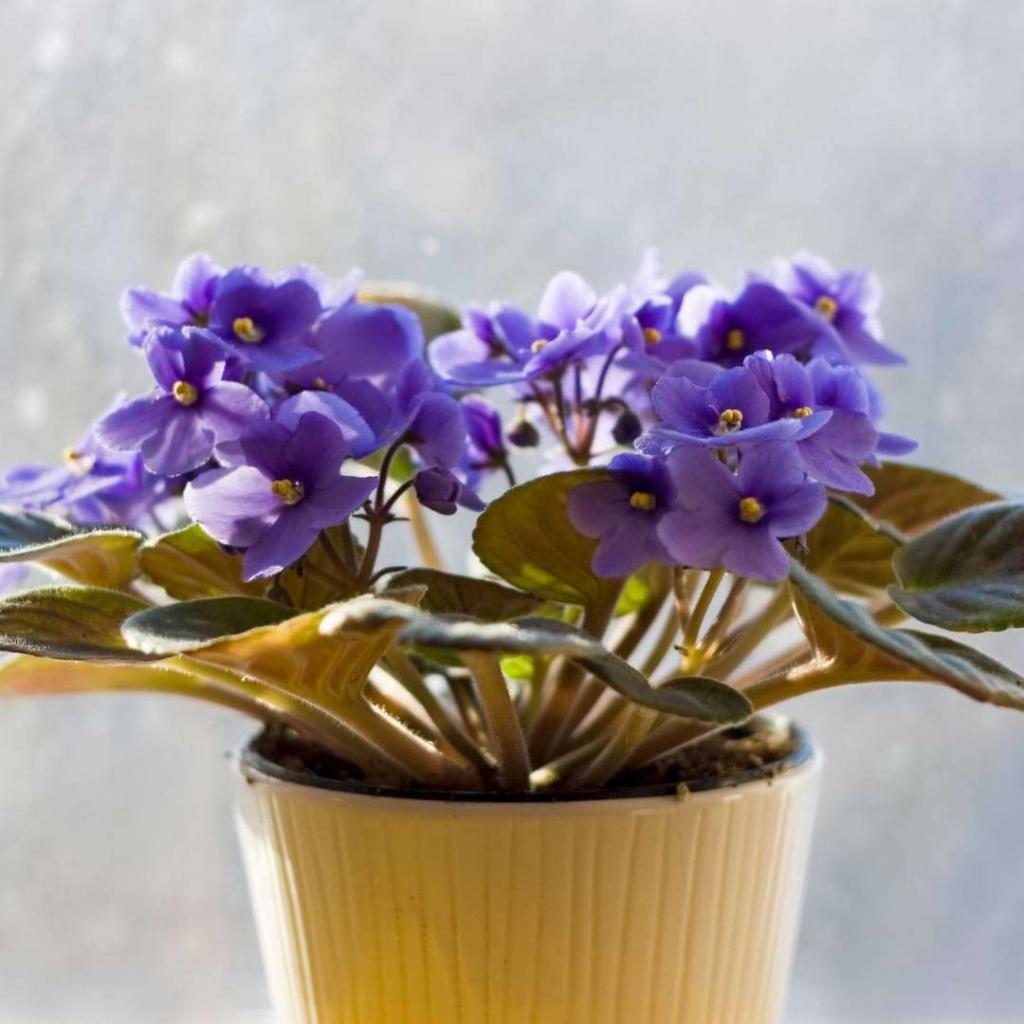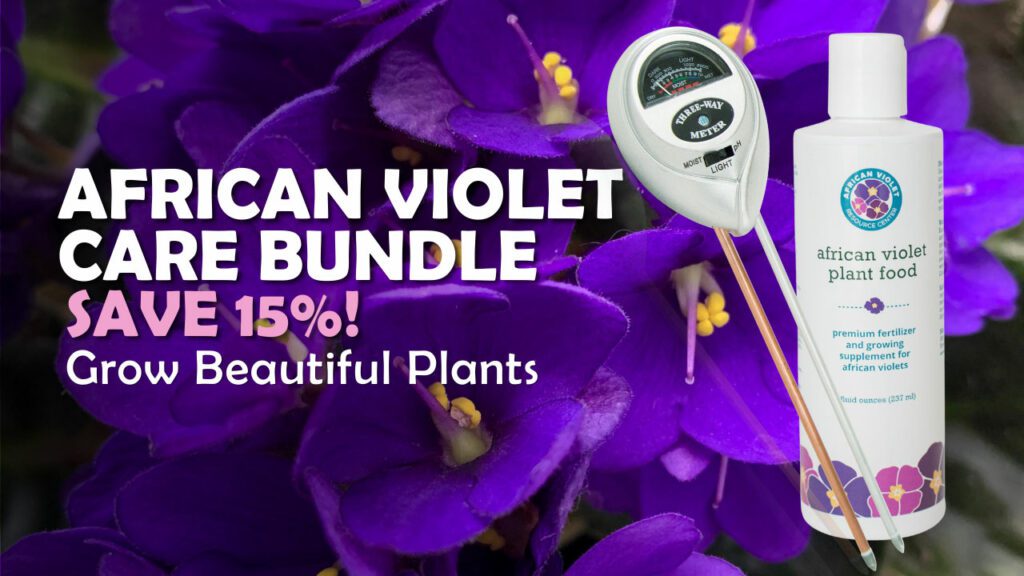Saintpaulia Ionantha is commonly referred to as African violet. The name Saintpaulia comes from the family name of the baron who first discovered the plant. The plant that was originally discovered was not easy to grow as a houseplant, but as new cultivars were created, the African violets became a beloved easy-to-grow houseplant.
The plant has a few specific needs, but for the most part, caring for Saintpaulia Ionantha is relatively easy.
Keep reading to find out how to care for your Saintpaulia Ionantha African violet to keep it thriving and prolific.
Facts About Saintpaulia Ionantha African Violet
Common Name: African violet
Botanical Name: Saintpaulia Ionantha
Seasonality & Life Span: Can bloom 10-12 months a year, life span up to 50 years
Flower Color: Most commonly purple, hybrids may be purple, blue, pink, or white

How to Care for Saintpaulia Ionantha African Violet
Saintpaulia Ionantha African violet and its hybrids are such popular houseplants because they are relatively easy to care for. Saintpaulia Ionantha African violets are even more tolerant of a little neglect than most hybrids are.
That being said, you still need to be aware of a few requirements for your Saintpaulia Ionantha to thrive. Then you’ll get to enjoy their beautiful blooms for as long as possible throughout the year. Neglected African violets may survive, but they won’t provide the same prolific blossoms as properly cared for African violets.
Position
Saintpaulia Ionantha needs a warm, sunny location; however, harsh direct sunlight during the middle of the day can damage the leaves. Windows facing east or north are usually better in the summer, while windows facing west or south are better in the winter.
Finding the right location in your home is usually the trickiest part of caring for African violets because they require so much sunlight to thrive. Once you find the right location, the rest of the care is easy. It may take several months of trial and error to get African violets in exactly the right location.
Temperature
Saintpaulia Ionantha is happy to thrive at the average household temperature. They do best at around 70 degrees Fahrenheit but do well as long as the temperature is between 60-80 degrees Fahrenheit. While excessive heat can harm African violets, temperatures that drop too low are more dangerous.
Try to avoid placing Saintpaulia Ionantha in environments where it will be exposed to temperatures below 60 degrees for more than a short period of time.
Light
Light is the biggest area where African violets are particular. Saintpaulia Ionantha needs bright, indirect light to thrive. For many people, the most difficult challenge with African violets is providing enough light for the plant to flower. For the best results, these plants need at least 12 hours of sunlight and 8 hours of darkness to bloom consistently.
You may need to reposition your Saintpaulia Ionantha several times as you figure out which window in your home provides the best light situation. As seasons change, the best position for your African violet may change as well.
During certain times of the year, it can be difficult to provide enough light to encourage your African violet to continue blooming. During the winter, you may need to supplement the amount of natural light by using grow lights or artificial lights. Of course, even though African violets can bloom 10-12 months a year with enough light, you can also just let your plant rest when your home doesn’t get enough sunlight. As long as your African violet gets several hours of sunlight, it will stay healthy—it just won’t bloom the entire time.
Watering
Saintpaulia Ionantha prefers to have just enough water to keep the soil moist but not overly wet. Use your index finger to see how moist the top inch of the soil feels. If the soil is completely dry, it’s probably time to water. African violets can handle a little bit of drought; it’s okay if the soil dries out completely sometimes as long as you don’t go too long without watering. On average, expect to water every 7-10 days, but this timing depends on lots of factors, including the environment, the season, and even the container.
Use room-temperature water. Avoid getting water on the leaves because lingering drops can cause white spotting. There’s also a small chance of encouraging crown rot if water pools up for too long.
In my opinion, bottom watering is the easiest way to water African violets, but as long as you’re careful to avoid spilling water on the leaves, top watering is just as effective.
Be sure to use a plant container or pot that allows water to drain from the bottom when you water. If excess water cannot escape, your Saintpaulia Ionantha runs the risk of developing root rot.
Should I mist my Saintpaulia Ionantha?
African violets enjoy an environment with some humidity, so if your house is not humid enough, misting can help with this issue. However, you should only mist early in the day when water droplets will easily evaporate before nighttime.
Misting does have a small risk of causing white spots or possibly encouraging fungus to grow on the leaves. As better alternatives to misting, try grouping plants together to create a humid microclimate or place shallow trays of water near your Saintpaulia.
Fertilizing
Your Saintpaulia will grow best in a small pot, but this means it won’t have access to as many nutrients as it would in its native environment. Applying small amounts of fertilizer can help your African violet stay happy and continue blooming as long as possible.
Look for a gentle, balanced fertilizer, one where the NPK ratio (the amount of nitrogen, phosphorus, and potassium) is the same for each element.
Liquid fertilizer is the easiest to use because you can dilute as needed. I’d suggest diluting the fertilizer even more than the package calls for unless you have a formula that already has very small amounts of fertilizer. Too much fertilizer can be harmful to your plant, but a little can keep your Saintpaulia thriving.
Pruning
Remove spent flowers and leaves from your African violet as you notice them. You can pinch both flowers and leaves off just using your fingers or use scissors to cut off the spent blooms.
There’s no reason to leave dried flowers on your plant once they have finished blooming. They just get in the way of the new, beautiful blooms that will hopefully be appearing next.
As your Saintpaulia ages, you’ll need to remove the lowest layer of leaves. It’s natural for these bottom leaves to die off as they age. New leaves form near the crown.
Repotting
African violets need to be repotted with fresh potting soil regularly. The general recommendation is to repot twice each year, but at minimum, you should repot whenever your plant becomes root-bound (when the roots begin to circle around the edges of the container and eventually try to grow out of the container for more room).
Worried that repotting is difficult? Don’t be. For African violets, repotting is a simple process. All you need is fresh soil, possibly a new container, and a few minutes.
To remove your Saintpaulia from its current container, simply tip the container on its side and gently coax the plant from the container. If you are using a clay pot, watering the plant before trying to remove it can make the process easier. If you are using a plastic pot, the plant will likely slide out pretty easily.
You should repot in a larger container only when your African violet has outgrown its current container. Otherwise, either clean and reuse the current container or pick a new one in the same size. African violets grow best in small containers; containers that are too large can hold on to too much water and damage the plant’s root system.
Gently remove the excess soil from the root ball. Then place enough fresh soil in the container that your plant’s bottom leaves will just reach over the edges of the container. Place the plant in the new container and carefully fill in the gaps between the plant and the container sides with soil.
Once you’re happy with the positioning, it’s time to water your repotted Saintpaulia. Place your plant in a shallow container of water and give it a few minutes to soak up as much water as it needs.
Expect to see a little bit of drooping and stress in your Saintpaulia after repotting—but don’t worry; after a few days, it will perk back up and look even better than before.
Propagation
Part of the reason African violets are so popular with houseplant owners is because they are so easy to propagate. It’s not difficult to propagate more Saintpaulia to keep for yourself or to share with friends.
The two easiest methods for propagating African violets are leaf cuttings and division.
To propagate new African violets from leaf cuttings, start by selecting a healthy leaf on your Saintpaulia. Using sharp scissors, remove the leaf from the plant. Allow 1 to 1½ inches of the stem to remain attached to the leaf. Place the leaf in a container filled with growing medium. If necessary, use a small stick or tag to prop up the leaf. Water the cutting, thoroughly allowing excess water to drain away. Then cover the cutting with a plastic bag to help keep moisture in.
Place the container in a sunny location. You can expect the plant to form roots in about 3 to 4 weeks, and leaves should develop in about 6 to 8 weeks. I’d encourage you to take several cuttings at once in case a few of the cuttings aren’t successful. You’ll probably have extras, but you can always share.
To propagate new African violets through division, you’ll need to check your plant to see if it has developed more than one crown (the area where the leaves appear to cluster around). If your Saintpaulia has developed multiple crowns, you can gently untangle the two root systems and place the clusters in their own individual containers with fresh African violet potting soil.
All the crowns you separate should continue developing without any issues. This method is simple and reliable, but it does require you to wait until your African violet develops multiple crowns. It doesn’t happen too often so you might be waiting for a while.
Pests and Diseases
Saintpaulia Ionantha African violets can suffer from pests and disease, but it’s relatively easy to keep your plants healthy and avoid any issues.
Here are the pests and diseases to watch out for.
- Crown and root rot: African violets can easily develop crown and root rot, which causes roots and leaves to die. To prevent this problem avoid overwatering and be sure your plant’s container allows excess water to drain.
- Mites: These pests are a huge problem for African violets. The mites are too small to see, but you’ll notice stunted leaves and leaf curling. Try to prevent mites in the first place by spacing plants far enough apart that mites cannot move from one plant to another. If a plant is infected, a miticide for houseplants can be used. Since African violets are easy to obtain, most houseplant owners just get rid of infected plants rather than deal with the hassle of getting rid of mites.
- Mealybugs: Mealybugs are tiny pests that are about ¼ inch long and have a white waxy covering. Once these pests infect houseplants, they’re difficult to get rid of. It’s best to inspect any new plants for mealybugs before bringing them in the house. Insecticides can take a long time to get rid of a mealybug infestation. Most African violet owners get rid of infected plants to prevent mealybugs from spreading rather than trying to save a plant that is already infested.
Join the African Violet Club!
Whether you’re just starting out or are a seasoned grower, African Violet Resource Center has everything you need to help your plant grow vibrant and strong. Explore our other articles, visit our online shop, and connect with other houseplant lovers in our Facebook group to learn everything you need to know about this rewarding hobby!
More Great African Violet Resources
Why Are My African Violet Leaves Curling?
How to Remedy Crowded African Violet Leaves







